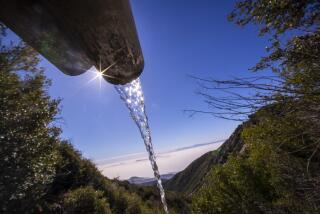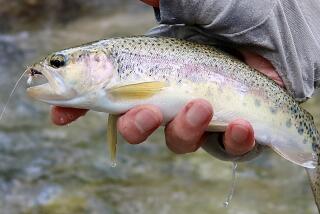Suit Aims to Save Rare Fish Near Planned Mine
- Share via
A lawsuit aimed at protecting an endangered fish is unlikely to change a U.S. Fish and Wildlife Service ruling in favor of a proposed gravel mine near Santa Clarita, officials said this week.
The suit brought by the Center for Biological Diversity based in Tucson states that the wildlife service failed to designate “critical habitats” for the unarmored threespine stickleback along the Santa Clara River and three other locations. Under the Endangered Species Act, federal agencies may not approve projects that would destroy or seriously alter areas designated critical habitats.
The lawsuit, filed Tuesday in U.S. District Court, seeks to force the wildlife service to reconsider its 1998 opinion that the Transit Mixed Concrete Co. mine will not harm the stickleback. The mine would extract 78 million tons of sand and gravel from Soledad Canyon, just east of Santa Clarita.
The inch-long stickleback was once abundant in Southern California, but its population has dwindled in recent decades, partly because of unchecked development, environmentalists say.
“There are a number of projects proposed and ongoing that would adversely modify or destroy critical habitats [around the river],” said Peter Galvin, a biologist with the center. “The Soledad Canyon mine is one of them.”
Fish and Wildlife spokeswoman Lois Grunwald said Monday that a successful lawsuit could prompt a new review of the agency’s decision, but it probably would not change its opinion. In many cases, designating habitats does not “create a higher level of protections” for endangered species, she said.
Galvin said Grunwald’s statements were “absolutely incorrect,” and added that he hoped the lawsuit would help clarify the level of protection that should be afforded to federally designated critical habitats.
The Santa Clara River is prone to dry spells that kill off the stickleback. Water drawn from the river for the mining project would probably mean longer dry periods, but the wildlife service has determined that any threat to the fish would be negligible, agency biologist Ray Bransfield said.
The federal government, which owns the land, has already directed Transit Mixed Concrete to monitor river levels to protect the fish and another endangered species, the arroyo toad, Bransfield said. The mine would be temporarily shut down if the water levels get too low.
In the suit, the Center for Biological Diversity asks that critical habitats be designated in Soledad Canyon, two streams in the river watershed and in the lower San Antonio Creek on the Vandenberg Air Force Military Reservation in Santa Barbara County.
Galvin said Fish and Wildlife had proposed protecting those areas in 1980 and was required by law to finalize the habitat designation within a year.
“The Fish and Wildlife Service has let this languish out there for 20 years,” he said.
Grunwald said she was not sure why the agency had waited so long. But she noted that expanding the endangered species list has generally taken precedence over habitat designations.
The green-gray stickleback was found throughout the Los Angeles area in the early 20th century. By 1942 it had become so scarce that biologists believed it was extinct. It was declared a federal endangered species in 1970.
The Soledad Canyon mine was approved by the federal Bureau of Land Management in August 2000. The city of Santa Clarita, the Sierra Club and other groups attempted to overturn that decision, arguing in part that federal agencies did not adequately address the mine’s effect on endangered species.
Last week, the U.S. Interior Department rejected that appeal. The project must still be approved by the Los Angeles County Board of Supervisors, which will consider it Feb. 26.
More to Read
Sign up for Essential California
The most important California stories and recommendations in your inbox every morning.
You may occasionally receive promotional content from the Los Angeles Times.










